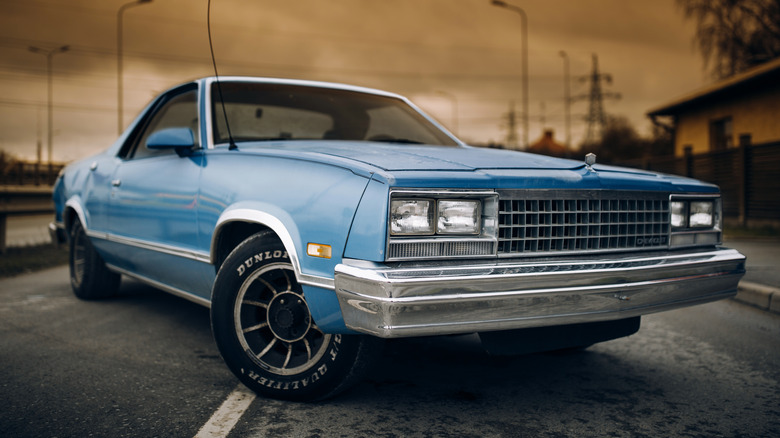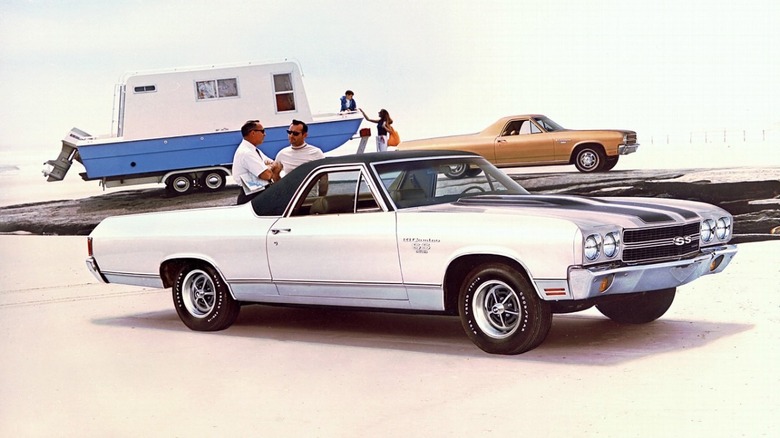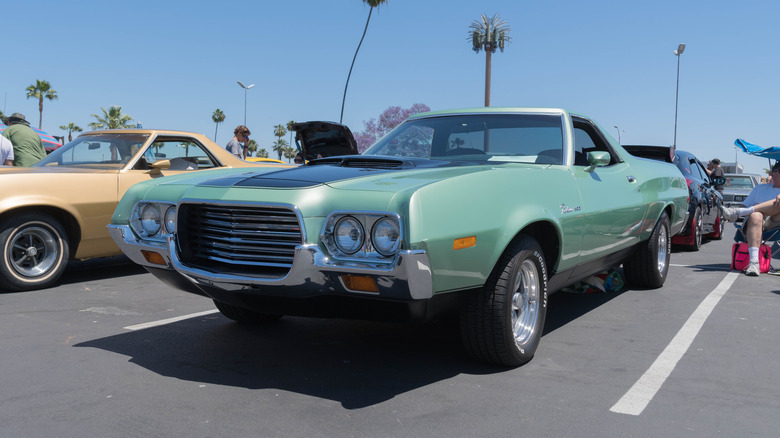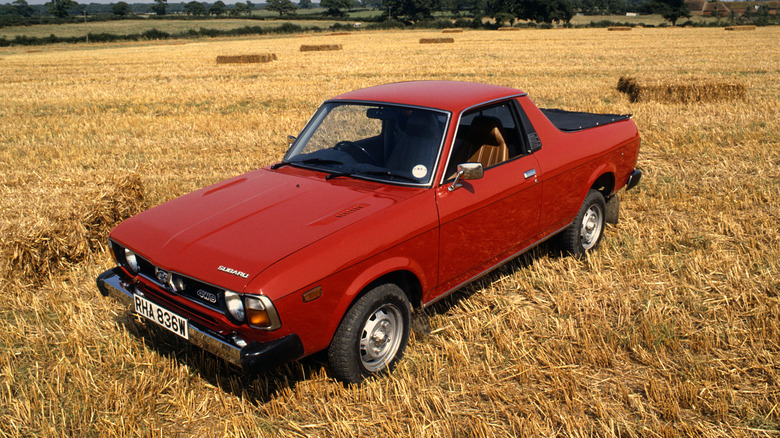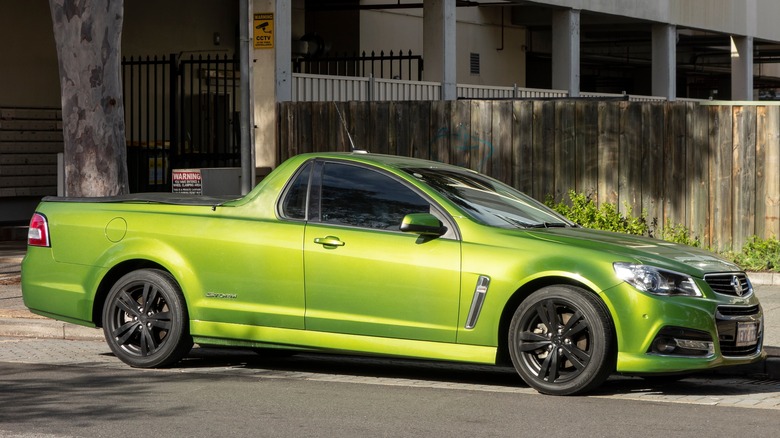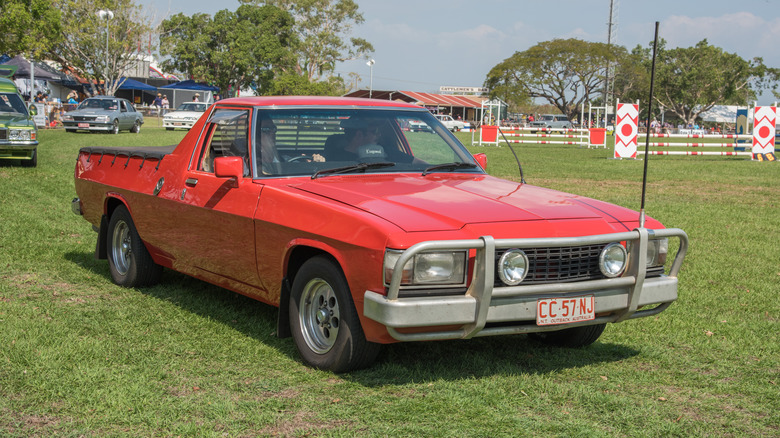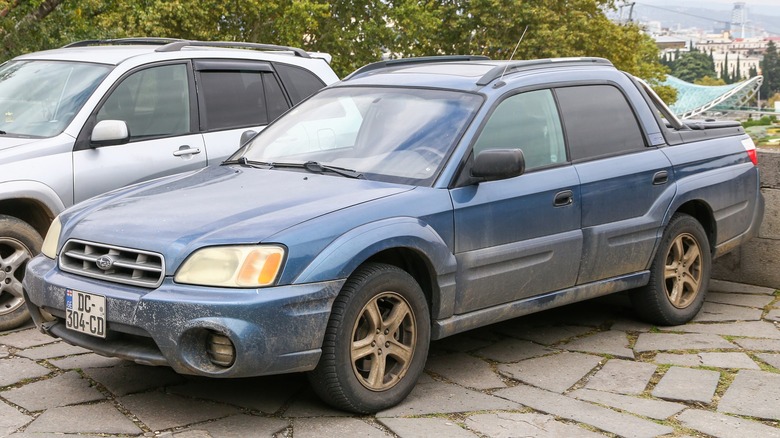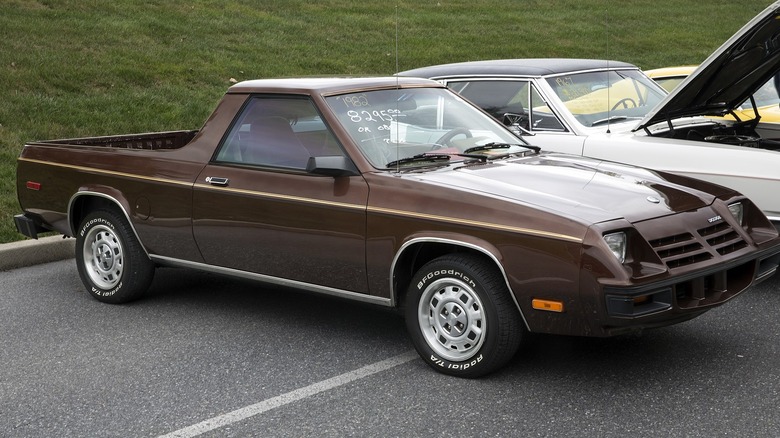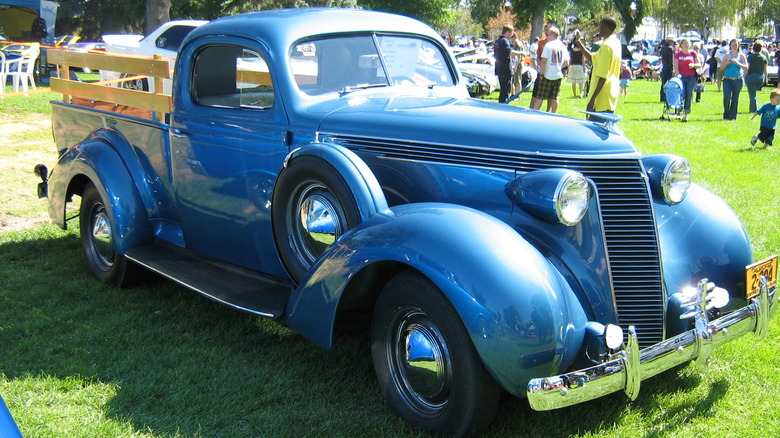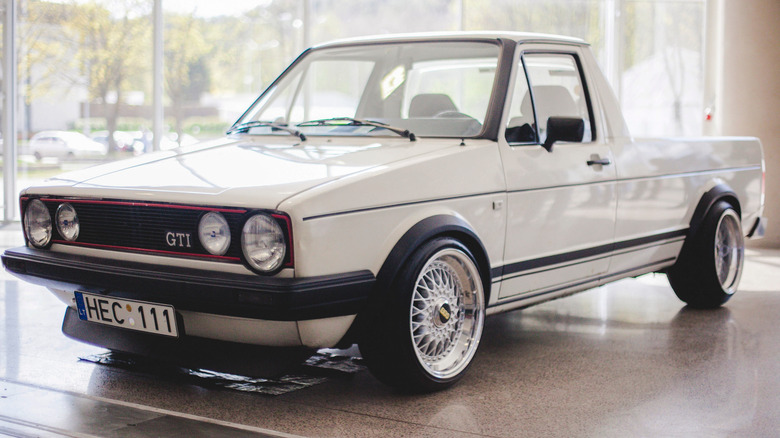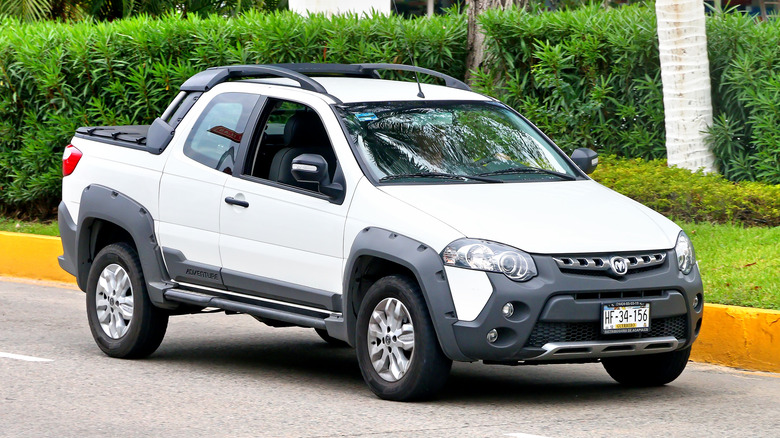The 10 Best Utility Coupe Car-Trucks Of All Time
Major auto manufacturers have for decades tried vehicles to meet the varying demands of consumers while innovating to offer new products. The goal has always remained the same: to entice buyers into new types of products. Early on, carmakers found that they could convert their existing automobiles to work service by replacing passenger areas with cargo hauling equipment. The Model T was custom built to suit a wide variety of purposes from open bed trucks to enclosed vans (via Old Cars Weekly). Some were even put into farm service with tractor-like implements powered by the car's 25-horsepower engine.
As the industry matured, new formats and layouts for vehicles emerged, and the car-based truck became a popular addition to new car model lineups. The naming of these vehicles has never been universally standardized. Australians call them utes. Bakkies is the preferred term for South Africans. In the U.S., ute could be interchanged with the truck or, more specifically, El Camino. The North American nomenclature remains ambiguous today. Regardless of the name, these vehicles have remained popular with car enthusiasts, though they have fallen out of favor with buyers in the United States. These are the ten best utes from around the world.
Chevrolet El Camino
The granddaddy of them all is the Chevrolet El Camino. Of car-truck hybrids, it was not the first and may not necessarily be the best, but it does have the most name recognition. Sales of the El Camino and its sibling the GMC Caballero were strong from its beginning in the late '50s and declined from the late '60s until its demise in the mid-'80s. The car model that served as its base changed throughout the years but the basic format of a comfortable, car-like truck with seating for two or three remained constant. The other constant for the El Camino is its stunning good looks. Throughout its production, it was an attractive alternative to full-size pickups.
The first El Camino graced us with its presence in 1959, based on the Brookwood shooting brake with styling elements borrowed from the Bel Air and Biscayne, according to Eckler's Classic Chevy. It saw immediate success, selling more than 20,000 units in each of its first couple of years. Subsequent models would share their styling and chassis with the Chevelle, one of the most popular muscle cars of all time. This generation spawned special editions such as the SS 396, featuring huge big-block power. The last couple of generations shared their styling with the Malibu, becoming slimmer and lighter for the last iteration. GM continued production until 1987, when tough, efficient, and highly capable compact pickups hit the market and lowered demand for the car-based trucks, according to The Drive.
Ford Ranchero
For the American market, the Ranchero was the first of the post-war utes (via Hagerty). It premiered in 1957, showing up as the Ford Ranch Wagon if someone took a chainsaw to the rear cargo area of it. Being a shooting brake, the Ranch Wagon was the perfect basis for the Ranchero, and it immediately proved to be popular. In the mid-'50s, Ford had several offerings for station wagons and wanted to expand its offerings to dominate the space. This was the genesis of the Ranchero. In that era, trucks were commercial vehicles that would be considered too austere for family use yet a wagon could be too constrictive for hauling some cargo, such as furniture. The Ranchero was a perfect alternative for its time.
The Ranchero continued to be that ideal alternative for another seven generations after its introduction. According to Hagerty, the Ranchero was in production from 1957 to 1979, undergoing six changes in body style and offering an array of six and eight-cylinder engines. The sales of the Ranchero never matched those of the El Camino but sold well enough to keep it on the road for decades. The Ford Courier of the seventies and the upcoming Ranger for the eighties led Ford to discontinue the Ranchero in 1979.
Subaru BRAT
Subaru's BRAT, or Bi-Drive Recreational All-terrain Transporter, is probably the quirkiest vehicle ever sold. Entering the market at a time when American consumers were being introduced to the hearty and economical Japanese small pickups, Subaru took a novel approach in a few ways. The BRAT was lumped in with the other small trucks but is based on Subaru's car chassis, the Leone, or GL in North America. The BRAT is a less capable truck than some of its competitors and also differed itself due to being all-wheel-drive and having passenger seats in the bed.
The quirkiest bit of the BRAT is the rear-facing seats in the bed, but there was a good reason for them to be installed. Subaru sought to avoid a 25% tariff commonly known as the "chicken tax" applied to light truck imports (via Motor Trend). The inclusion of the rear seats turns the BRAT into a passenger vehicle, avoiding the tariff. If buyers wanted a truck, they could simply remove the seats. Safety was not much of a consideration but, for kids, riding in the back was all about fun.
Holden Ute
The Australian embrace of the car-truck hybrid had long legs starting in the '30s. The first Aussie ute was created by General Motor's down-under division, Holden, in 1933. The story goes that a customer wrote to the company asking for a vehicle appropriate to take to church on Sunday and then haul the pigs to market, and so the utility vehicle was born (via Motor Trend). While this vehicle went through many changes over the years, it was among the final versions that stand out as the king of the utes.
Unlike Americans, Aussies had the opportunity to buy a factory-built ute all the way until 2017 when all Holden production ended. The final utes are based on the Commodore sedan, a version of which was imported to the United States as the Chevy SS, a powerful sports sedan with stunning good looks. The newest utes from Australia are powered by big, beefy V8 engines with loads of torque. The best of them is the Holden Maloo HSV, which became known as the best utility coupe car-truck of all time in its own right. Although Holden is defunct, the brand's special performance division website still exists and details the Maloo. It is powered by a supercharged 6.2-liter V8 with 550 horsepower, upgraded suspension and brakes, and a special appearance package. It is the supercar truck we all want stateside but shall never have.
Ford Falcon Ute
Never one to rest on its laurels, Ford could not concede the ute market to its southern GM rival. The Ford Falcon has been a staple on Australian roads for decades, available in a variety of packages from fleet cars to sports sedans to utes. Top Speed reported that the Falcon ute began production in 1961 and lasted all the way until the last one left the factory in 2017, undergoing multiple facelifts and platform changes along the way. The Falcon is a much-loved vehicle in Australia just like the Holden ute, as they both represent the independence of the Australian people (via The New York Times).
Speaking strictly about the latest and last version of the car, the 2014-2016 model year Falcon styling resembles the Fusion and Mondeo but is built on a unique Australian platform. The most unique feature of the Australian Ford is the usage of an inline six-cylinder engine as its primary powerplant. Australian Car Review lists the available engines as 4.0L petrol, 4.0L LPG, and 4.0L turbocharged petrol engine. The Falcon XR6 is fitted with a Garrett turbocharger and that engine puts out 362 horsepower under seven pounds of boost, making this ute not only useful but quick. The Falcon may not have been the bonkers tire-smoker that is its Holden counterpart, but remained an attractive, capable, and comfortable hauler for cruising down the Gold Coast or to the Outback.
Subaru Baja
More than a decade after the end of BRAT sales in North America, Subaru decided it was time for a sequel. However, this time they ditched the rear-facing seats in the bed and avoided those pesky safety-related lawsuits. Sales were brisk and manufacturing had been established in Indiana, according to Car Sales Base, negating any tariffs that could possibly be levied. On paper, the Baja was a fairly good vehicle, but in the showroom, it was a failure and only lasted three years.
Based on the popular Outback station wagon, the Subaru Baja kept most of the vehicle the same except for the cargo area, which was converted into a small bed. To make up for the small cargo area, the rear seats fold down and a pass-through called the Switchback opens up to allow cargo to extend from the bed into the rear of the passenger compartment. A clever innovation to make up for its short cargo space is that when the bed is laid down, the license plate holder is hinged such that it hangs down and remains visible to those traveling behind the car (via Car and Driver).
The Baja was about as quirky as it gets, even from a company known for being quirky. Motor Biscuit looked back on the Baja and found it to be a fun and relatively capable vehicle despite its poor sales numbers, and that values are rising today as collectors looking for unique cars remain drawn to it.
Dodge Rampage
Among efforst from Dodge to gain traction in the '80s those efforts was the Rampage, a small car-based truck that originated in France. The Dodge Omni started development with origins coming from Chrysler subsidiary SIMCA in France and ended up being a hugely popular car in the U.S that helped save Chrysler from bankruptcy (via Allpar). The trucks are largely forgotten and mostly unassuming but one model did come from an even more important partnership.
The last year of the Dodge Rampage spawned a high-performance model breathed on by Carroll Shelby himself. During his stint making four-banger Mopars scream with turbos and Shelby magic, a CS Rampage went on sale. It had the front end from the Shelby Charger and featured the same turbo 2.3L engine from the GLH (via Allpar). It ran like an American hot hatch with a pickup bed and looked pretty cool, to boot. Not many were made and today they make a great collector car.
Studebaker Coupe Express
Americans got a late start in adopting car-trucks. Studebaker jumped on the trend starting in 1937 when they converted their Dictator coupe into a truck, via Studebaker Museum. The South Bend, Indiana, company only built 5,700 of these over three years, and failed to gain much ground. As such, the car is tough to find these days.
Built long before monocoque chassis was the norm, the Coupe Express was a fairly simple adaptation of the standard coupe. Cars were built on heavy frames that should have been strong enough for a fairly hefty payload. The only thing that might hold them back is the engine, a 218 cu. in. inline-six making all of 86 horsepower, according to Heacock Classics. Regardless of capability, it is an attractive automobile. The rear fenders blend into the bed in a way that gives the truck a classy look, while the tall, straight lines of the grill sweep back down the length of the hood to produce a distinctive appearance. Being built in 1937, the Studebaker is somewhat austere as a reflection of the Depression but is also decorated with subtle art deco flourishes that make this truck an unmistakable heirloom of its era.
Volkswagen Rabbit Pickup
For five years starting at the dawn of the '80s, a rural factory in Pennsylvania produced one of Volkswagen's most innovative American products, the Rabbit Pickup. According to Road and Track, VW was the first foreign manufacturer to set up shop in the U.S. since Rolls Royce pulled out in 1931. The new plant would produce the all-new Golf for North America with the name changed to Rabbit. Among the many decision to tailor it for Volkswagen's American market was one idea to chop up the rear of the car and make a truck. It would not make it to Europe for another two years.
The Rabbit Pickup is identical to the hatchback version from the b-pillar forward, sharing the same interior, body panels, and engine choices as the car. Those engine choices included a 78-horsepower 1.7L gasoline engine or a 52-horsepower 1.6L diesel. While acceleration in the diesel could be timed in minutes rather than seconds, you could drive it to Mexico City on a single tank of fuel, shooting clouds of black diesel smoke behind you the whole way. Hemmings says that sales for the truck were mediocre and not enough for VW to want to keep investing to keep it alive. However, once production ended in the U.S., the tooling was sent to South Africa where it soldiered on until 2007, a remarkably long time for a car to be produced.
Ram 700
The idea of a car-based utility vehicle seems to be one that has seen its day come and go. The best American utes have long stopped being made and even the Aussies have ended production. Some car enthusiasts love them, but the consumers that actually buy cars for daily use don't feel the same love. However, they haven't completely fallen out of favor everywhere. In Mexico, Stellantis sells the Ram 700 to this day. It is itself a Mexican version of the Fiat Strada, a compact car-based truck, and offered on Ram Mexico's website as a commercial vehicle with either single or couple-cab variants.
Among the automotive press, several stories about this pint-sized pickup lament that this is not headed north of the Rio Grande. Autoweek suggested the market could possibly support it with the likes of the Hyundai Santa Crus and Ford Maverick going on sale, but no plans exist for the Ram to join them. It is built in Brazil for the Latin American market and that is not likely to change. But still, we can dream.
